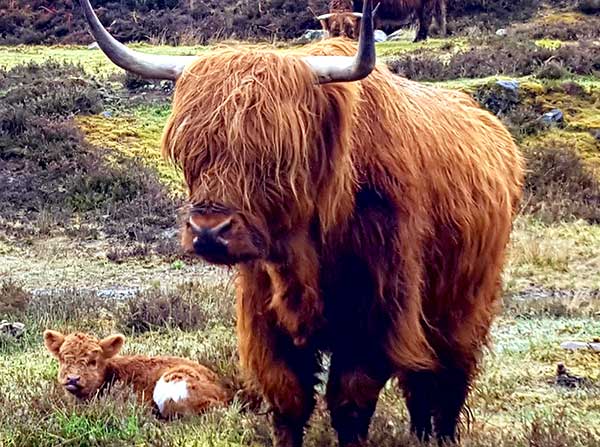|

|
|
Of
Coos and Bricks
By Mona Lease
Hi, all!! From the pictures and information that supported last week's
column...I'm submitting this column. There are some 500+ pictures from
the "J" Birds' jaunt across Scotland. The following is purely my
observation.
In the picture of Highland Park Distillery - you'll see the wrought
iron sign post says the distillery was established in 1798. This makes
the distillery 220+ years old.
By all accounts I've read - the distillery in the picture is the
original building. I love the scrolled wrought-iron work. This is
a brick building, set in the northern-most part of Scotland - namely
Kirkwall, Scotland. Kirkwall sets in a sort of deep cove at the edge of
the continent.
I think this is remarkable. The building would be exposed to the
elements of the Atlantic Ocean and surrounding sea elements. Someone
has taken the time to maintain the building through the years.
Originally - bricks were hand-made. A form of wood was made. The
materials were mixed in a huge container - usually wooden. The
materials were "stirred" with a metal blade on a long wooden
handle...which allowed for scraping the bottom and sides of the "vat."
The Brick Making Process
Clay Preparation: "Tempering" is adding water to the clay to seal it to
make it workable. Too much water will decrease the quality.
Another way to temper is to "weather" - which allows the clay to dry in
the sun and accept moisture from the rain and dew. Repeated drying and
moisturing of the clay will bring the clay to a plasticity and
workability appropriate for brick making.
Mixing is done to make the clay homogeneous and smooth. Different
admixtures like coal or sawdust can be added to the clay to: 1)Reduce
cracking during the drying and 2)Reduce fuel usage during the firing.
Molding: Bricks should have standard characteristics to be used in
construction. A standard brick size will allow you to more accurately
determine how many bricks you need for a project. Bricks will shrink
while drying. The mold needs to be larger than the desired size.
For best results, the drying should be done slowly. This helps them dry
more evenly.
Firing: A clamp is a field kiln built from the green bricks to be
fired. The process is in several steps: 1)Pre-heating removes the water
left from the drying process. 2)Firing, where the clay bricks will
vitrify (convert to another form...usually through heat) through a
chemical process. The temperature must remain constant at this stage
for complete vitrification. 3)Cooling, which must be done slow and
steady. A clamp may take two weeks to cool. (Modern methods have
reduced this process considerably.)
When I think about this - I think wow!! For some 220+ years - the
bricks making the building that houses the HIghland Distillery - have
withstood spray from the ocean, wind bringing moisture from the ocean
to the bricks, the sun's rays directly hitting the bricks, the sun's
rays reflected off of the surrounding water on to the bricks, and
they've expanded and contracted with the heat and cold. And still -
there they are!! Just WOW!!
"Coo" (cow) is defined as: Highland Cattle..Cow (Coo) or a Bull. They
have a docile temperament and their milk has a high butterfat content.
They are good-natured and very protective of their young.
The HIghland Coo (cow) is descended from the Hamitic Longhorn - second
millennium BC.
The Highland Cattle Registry ("herd book") established in 1885...is the
oldest herd book in the world. The "Coo" was registered in this book in
1885...making the Highland Coo the oldest registered cattle in the
world.
In 1954, Queen Elizabeth ordered Highland Cattle to be kept at Balmoral
Castle - where they're still kept today.
The Highland Cattle are raised primarily for their meat...which is
regarded as the highest quality. Because of this and the low
cholesterol level of their meat as compared to other beef
varieties...acceptance of the "Coo" is growing. (All of the above text
is taken from Wikipedia.)
MOOO!!
Remember the kiddies and our service people. Take good care of the
furry and feathered ones out there. Be safe and healthy. See ya next
time. Ever Toodles!! MONA
|

|
|
|
|

